On this page you will find exercise’s to help enhance your fitness levels so that you can be come a better hiker as well as some of the possible injuries that can and do occur with hiking and how to overcome them.
Exercise’s to help enhance your fitness levels for hiking:
These are great exercise’s to help get you in shape or in better shape for hiking. As always if you have any preexisting conditions or are concerned about an issue you are having with your joints, body, etc,…please consult you doctor or talk to exercise professional before starting a new exercise routine. All exercise’s are demonstrated by good friend and fellow trainer Bernie Simmons at the lovely club we work at Bay Club Carmel Valley in San Diego.
Please remember that these exercise’s show a small demonstration of progression from a beginning form of exercise to a more advanced form of exercise. The progression level for some of these exercise’s is endless, it’s really up to your imagination, what your ready for, and keeping good biomechanics in mind as you progress up in intensity levels. On the flip side, if you get hurt hiking, skiing, etc,…and cant perform at the levels you had previously reached, don’t be afraid to regress back to a simpler form of exercise until you are ready to slowly progress back up.
These exercises are meant to help increase your strength in your legs and your “core”. Remember to also work on your cardiovascular endurance. When your hiking and your breathing sounds like a locomotive, its not the strength in your legs that’s going to help you, therefor consider some sort of weekly routine for challenging your cardiovascular system so that you can keep up with the levels of hiking you may want to perform. All of this will help you on most hikes, but if you are going up past 8,000 feet in altitude levels remember that your lungs will be challenged as well and to keep an eye on how your body responds to the altitude, if you have any serious adverse affects you may want to head back down and save that hike for another day. For further information about altitude check this out: http://hikingdude.com/hiking-high-altitude.php
Backwards Lunges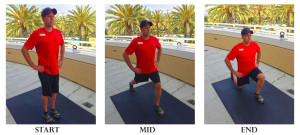
Backwards Lunges without any weight Start – Mid – End
Side Lunges & Multidirectional Lunges
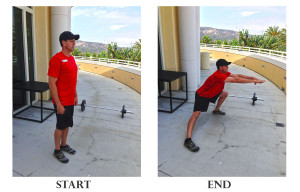
Side Lunge with no weight
1 Leg Balanced Deadlift
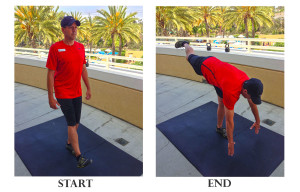
1 Leg Balanced Deadlift with no weight
Toe Raises: Balanced or for R.O.M
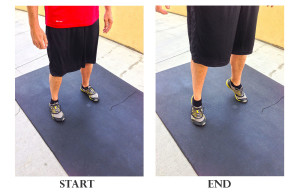
Calf Raise while balancing for more integration of the lower leg muscles.
Static Prone Plank
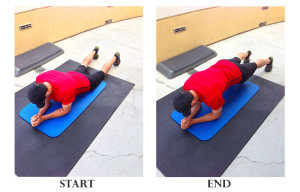
Static Prone Plank
Plants to Avoid while hiking in San Diego:
There are some plants that you really want to avoid at all costs while on the trail in San Diego. Everyone should be aware of the usual suspect in Poison Oak, but not everyone is aware of plants such as the Poodle Dog Bush, or the Jumping Cholla Cactus. Here is a good look at what to avoid.
Hiking Related Injuries
As with any sport, injuries can and do happen all the time. In order to keep those injuries from sidelining you its helpful to know what to look for, how to care for the injuries, and how to speed up the recovery time so that you can get back out on the trails. Most hiking injuries that are not directly related to some sort of trauma are usually the result of overuse. Some times just a little time off is all that is needed and somtimes you need to really buckle down and take the problem seriosuly in order for it to subside.
Common Hiking Related Injuries:
Blisters
Blisters are the number one foot ailment encountered by hikers – and they can turn the greatest hike into the most painful one. Blisters can be avoided by proper foot training; having the correct footwear and socks, and by early detection of possible problems
Steps to Avoid Getting a Blister
To avoid getting a blister, it’s necessary to understand how blisters are made. Common causes of a blister are friction and heat. Blisters are mostly caused by the friction between your skin and the inside of your hiking boot. Other causes include having wet or sweaty skin, which softens your skin, or having sand or gravel in your boot, which can increase friction.
Footwear
Your footwear is the most important purchase you will make as a hiker. Buying the right hiking boots will save you from getting a nasty blister. Your boot should fit like a snug glove. Find a breathable boot that provides good ventilation and reduces moisture. The boot should provide comfort and protection to your feet. Some stores offer a fake climbing slope to try out your boots. It is important that your foot doesn’t slide inside the boot while walking up or down hill. Your toes should have room to move, you should be able to wiggle them within the boot. A heavy hiking boot will take time to break it in, so walk around town first before tackling a 16-mile hike.
Socks and Liners
The next step is finding the right sock and liner. A poor quality sock, such as cotton, will trap heat and moisture against your foot, causing a blister. Wearing a wool sock such as Merino wool and a sock liner, will wick moisture away from your foot, allowing your foot to breath as the heat escapes away. Merino wool comes from Merino sheep reared in Spain, known to have the finest and softest wool. It is worth the price to pay for a high quality sock such as Smartwool or Fox River Wick Dry. Buy a sock liner such as Wigwam that will wick moisture away from your feet.
Prevention
Be sure to give yourself and your feet a rest. If you feel your feet are becoming overheated or moist, take a break and either cool down or change your socks. If you cool your feet in a stream, be careful to completely dry your feet before putting your boots back on. Change the rhythm of your walking or pace or stride. This will help stop friction from hitting the same areas of your body. If you are backpacking, take a pair of sandals with you. This will allow your feet to cool down at your campsite and provide rest for your toes, ankles and heel sections.
Many would say that prevention is the best medicine. If an area becomes hot or irritated, stop your hike immediately and deal with the problem. Apply moleskin to the effected area before moving on. Moleskin is an artificial skin that can be cut into shapes and applied to your skin. I have used this product and would highly recommend it. Others swear by duct tape. Remove any moleskin once you have stopped hiking and let your skin recover overnight.
What to do if you do get a blister?
According to the Mayo Clinic Education and Research Center’s website, don’t puncture the blister unless it’s painful or prevents you from walking. The unbroken skin over a blister provides a natural barrier against bacterial infection. If you have to pop the blister, use a sterilized needle to puncture the blister near the edge of the blister. Apply antibiotic ointment and cover with a bandage or gauze pad. Look for signs of infection around the blister, including pus, redness or increase of pain.
Plantar Fasciitis
The plantar fascia is the flat band of tissue (ligament) that connects your heel bone to your toes. It supports the arch of your foot. If you strain your plantar fascia, it gets weak, swollen, and irritated (inflamed) Then your heel or the bottom of your foot hurts when you stand or walk.
What causes plantar fasciitis?
Plantar fasciitis is caused by straining the ligament that supports your arch. Repeated strain can cause tiny tears in the ligament. These can lead to pain and swelling. This is more likely to happen if:
- Your feet roll inward too much when you walk (excessive pronation).
- You have high arches or flat feet.
- You walk, stand, or run for long periods of time, especially on hard surfaces.
- You are overweight.
- You wear shoes that don’t fit well or are worn out.
- You have tight Achilles Tendons or calf muscles.
The most common symptom of plantar fasciitis is sharp or knifelike heel pain that usually occurs when a person gets up in the morning and takes the first few steps. The pain also may occur when the person stands up after sitting for a period of time.
Home treatment, such as rest, ice, strengthening exercises, flexibility exercises, and orthotic devices, may relieve symptoms. A doctor may recommend medication, splints, surgery, or physical therapy.
IT Band Syndrome
Achilles Tendinitis
Muscle Cramps
On long and strenuous hikes, continuous sweating, especially when drinking a lot of fluid, can push your sodium levels too low and produce muscle cramping. Muscle cramps are caused by sodium losses, not potassium or magnesium. Although the amount of salt in sweat varies, most people lose about 800 mg for every two pounds (one quart) of sweat. Some people are salty sweaters and lose much more, regardless of their fitness level or degree of heat acclimation. Salty sweaters generally have white stains on their shirts/shorts and the sweat burns the eyes.
- Make sure you bring along some sort of electrolyte drink to help keep this from happening ( even so you may still have this happen, its happened to me on several occasions and it takes days for my legs to feel normal again)
- Bring along salt tablets if this happens to you regularly (check with your doctor if you have high blood pressure)
- I find a little bit of rest when it happens and some light stretching of the affected area can help.